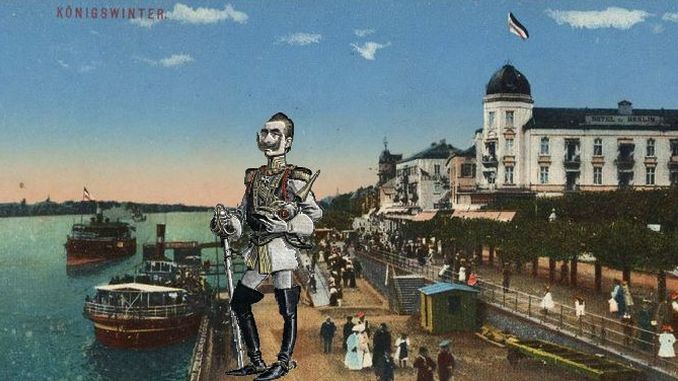
Germany around 1900, named Wilhelmine Era after Kaiser Wilhelm II. For many people, life was good. It was the time of impressionist and expressionist painting, historicism and eclecticism in architecture, and, turning away from old styles, art nouveau. In the “Belle Époque” people enjoyed their lives – at least those who could afford it.
Kaiser Wilhelm II
The last German Emperor is a controversial figure. We remember his speeches, loud and blowing his own trumpets, that created the ugly image of the aggressive German Emperor. Yet, he was very insecure and suffered from emotional instability and depressions. His birth had been a traumatic experience for mother and son. He survived only thanks to a courageous midwife.
However, his left arm remained withered, and that was a personal catastrophe for the Crown Prince and his mother. In the following years he had to undergo all kinds of medical treatments that often enough seemed torture. Wilhelm took great care in hiding his arm, but it haunted him. Throughout his life, he held his mother responsible, and she only seldom found a good word about him. He adored his British grandma, Queen Victoria, and his German granddad Wilhelm I.
Like his father, Wilhelm studied at the university in Bonn, founded by his great-grandfather Friedrich Wilhelm III. He studied law and also took natural sciences and archaeology classes. After Bismarck’s “Kulturkampf”, the Crown Prince’s time in the Rhineland helped to ease the relationship between the Catholics and the Protestant Hohenzollern dynasty. Unlike Bismarck, William II did not go for confrontation with the Roman Catholic Church.
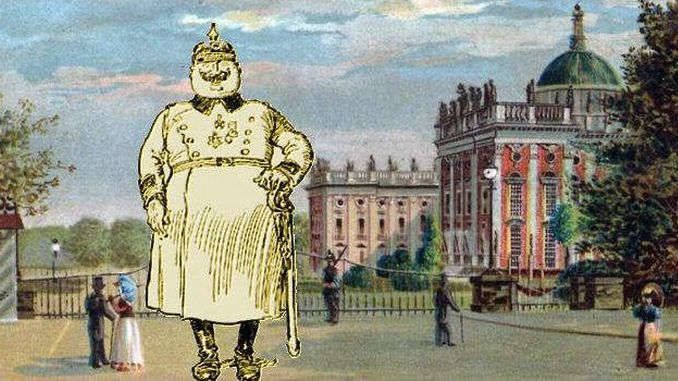
Break with Bismarck
At the beginning of his reign, Wilhelm wanted to be a good Emperor for all his subjects, especially the poor. When coal miners in Silesia went on strike, he received a delegation instead of sending troops to crush the strike, as Bismarck had suggested. “I do not wish to stain my reign with the blood of my subjects,” he said. When Bismarck suggested a new, even harsher tightened Anti Socialist-Law, Wilhelm turned him down. He wanted an even better social policy to reconcile the working class with this state. Only later, when the Social Democrats voted against all his social laws, he cursed, resigned and angry at the same time, at the “unpatriotic bunch” (in German: vaterlandslose Gesellen) and fought them with might and main.
Despite of all his achievements, Bismarck’s time was over when Wilhelm set out to rule by himself. Above all, the young Kaiser did not want to stand in the shadow of the far too powerful Chancellor. Bismarck, however, had been the second-to mightiest, if not the mightiest man in the Empire for almost thirty years. Now he felt downgraded and did not intend to cede power to Wilhelm. Finally, on March 20, 1890, Bismarck was dismissed.
He spent the last years of his life on his Gut Friedrichsruh close to Hamburg, with his family and his beloved great Dane dogs.
The modern industry state
Wilhelm felt he was the representative of a new generation, a modern and progressive ruler living in a time of tremendous technical progress. He and his empire stood on the edge of a new century in which things would get better and better. “Glorious times” (in German: “herrliche Zeiten”), were about to come. In turn. Many people considered Wilhelm to be the perfect monarch for them.
Wilhelmine Germany was a modern industry state, a “High-Tech location” as we would say today. Behind the USA and Great Britain, Germany was among the world’s leading economic powers. Not only the iron and coal industry of the Ruhr area, in the Saarland and in Upper Silesia, also the industries relevant for the future chemistry – pharmacy, electrical engineering and optics – contributed to the economic boom. Many Nobel Prizes went to Germany. In Berlin and other big cities one could see motor cars, trams and electric light.
During the 19th Century the population had grown rapidly. The national income almost doubled from 1896 to 1912, and since wages and prices remained stable, all parts of the population benefited. Finally, the number of emigrants decreased.
The conservative authoritarian state
The Empire made big progress in the field of economy and industry and had colonies in Africa and Asia; but at home it remained utterly conservative. Wilhelmine Germany was a conservative authoritarian state. Wilhelm himself believed that he was emperor by the grace of God. Next to the Emperor, the military had the highest standing. Becoming an officer was the best career option for a young nobleman, and also for a career in a civilian profession it was highly recommendable to have served in the military. William himself always wore uniform.
The parliament, the Reichstag, however, had a pompous new building, but its standing was low. Back then, the chancellor and his Government were responsible to the Kaiser, not to the parliament as it is in today’s parliamentarian democracies. At the bottom of the social ranking were the socialists, and those that did not fit into the conservative middle and upper-class society.
Germany’s business tycoons like Krupp provided significant social welfare programs and good care to their employees as long as they stayed away from the Social Democrats and the trade unions. Nonetheless, the SPD got more and more votes, and in the general elections to the Reichstag of 1912, the SPD turned out as the strongest faction. However, as mentioned above, the Reichstag’s did not hold the power
A highly innovative time
The Wilhelmine Era was a highly innovative time in art as well, just think of the impressionists and expressionists, artist Käthe Kollwitz, and the writers Theodor Fontane, Gerhard Hauptmann and Heinrich Mann, just to mention a few. Wilhelm himself flatly rejected the modern arts of his time, both impressionist and expressionist painting and contemporary literature. After the first night performance of Gerhard Hauptmann’s drama “Die Weber” in Berlin, the Emperor cancelled his theater box as a protest, and many of his subjects approved.
If the Kaiser ever saw a picture by August Macke (1887-1914)? Macke lived for a long time in Cologne and Bonn; his house in Bonn, the August-Macke-Haus (Bornheimer Straße) today is a museum and open to visitors. August Macke and his close friend Franz Marc (1880-1916) belonged to the international artists’ group “Blauer Reiter” that had some important exhibitions in the years before World War I. In August 1914, Macke and Marc volunteered to fight at the front – they should not come back.
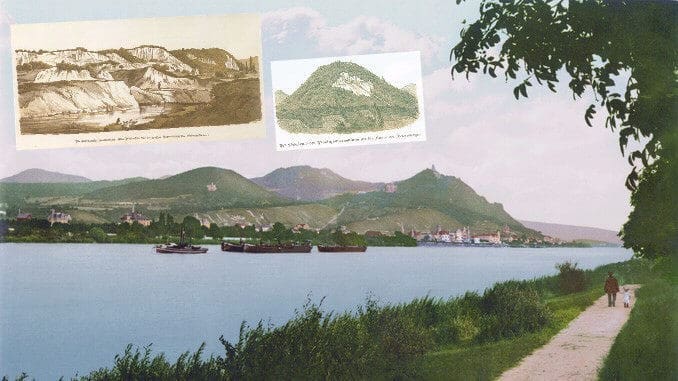
Back then in the Siebengebirge
In our region, people could enjoy their weekends and holidays in the Siebengebirge, there were plenty of restaurants, and cog trains went up to the Drachenfels and the Petersberg mountains.
On the other side, the Siebengebirge was in great danger. The Prussian government had stopped all quarries at the Drachenfels already in 1835, but quarries continued at the Petersberg and Stenzelberg.
Quarries
In the 19th and early 20th century, when more and more roads and railways were being built, basalt was needed, a stone that withstood even the greatest pressure So large quarries were opened at the mountains Weilberg, Petersberg and Ölberg. The Rhine front was soon devastated.
Tourism and Grand Hotels
Meanwhile, tourism had also become an important economic sector. Many people had discovered the Siebengebirge as a place for excursions and spent a lot of money in hotels, restaurants etc. Around the year 1900 there was already a representative hotel on the Petersberg. Later, in 1914, its new owner rebuilt it even more splendidly. It was Mr. Ferdinand Mühlens, head of “4711, Eau de Cologne”.
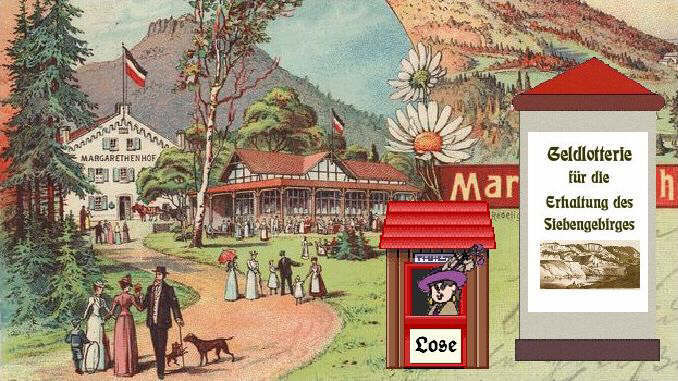
Initiatives to protect the Siebengebirge
Finally, the damage done to nature alarmed many people. They founded associations for the protection of the Siebengebirge. Later, they merged to form the Verein zur Verschönerung des Siebengebirges (VVS). Now there was a conflict of interests. The protection of nature stood not only against the interests of the quarry owners, but also against those of the quarry man. We also have to think of those indirectly affected, like the Heisterbach Talbahn railway who mainly did freight traffic from the quarries to the factories.
Back then there were no nature conservation laws with possible sanctions. The only option was to buy out as much land and existing quarries as possible and then close them. This required a lot of money, and in the worst case a right to dispossess quarry owners.
Fortunately, the VVS had allies among the Prussian authorities. Oberpräsident von Nasse, the highest representative of the Prussian crown in the Rhine Province, was on their side. In 1899, the Kaiser approved a money lottery with a net profit of 1,500,000 Marks for the preservation of the Siebengebirge, and also granted the right to dispossess. One year later, the VVS had collected enough money. Now they could buy out wide areas in the Siebengebirge and to close down numerous quarries. However, the quarrying continued until 1922 when the entire Siebengebirge area was put under protection.
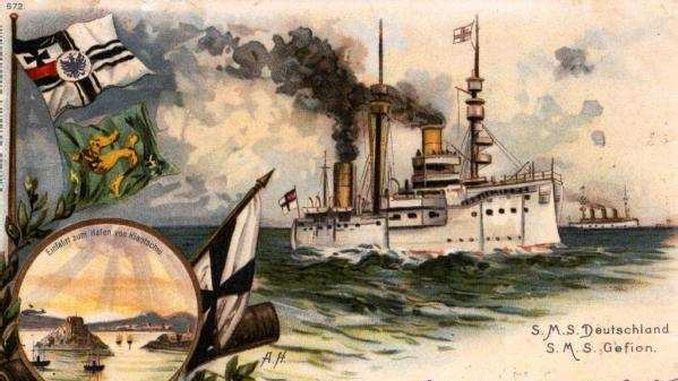
Germany’s “Place in the Sun”
The political situation in the world was tense, with European powers competing over colonies. Bismarck’s foreign policy had been careful. The German Empire had its colonies, but Germany’s security was the goal of his complicated system of alliances. This changed in the Wilhelmine era.
William II wanted Germany to have her “Place in the Sun” just as Britain and France. He behaved like the emperor of a world power, relying on Germany’s military and economic strength. Despite the tense political situation in the world, he proclaimed Germany’s claims loud and saber-rattling. Still today, his pithy, often overstepping speeches mark our image of him. Back then, they created the ugly image of the aggressive German Emperor, and Germany was rejected as an ally. The Boxer Rebellion in China 1900 and the Herrero Uprising 1904 in Southwest Africa were bloodily crushed.
The German foreign policy got the country more and more isolated. The foreign office considered Great Britain a “natural” ally because she conflicted with both Russia and France over colonies. But at the same time, a program of warship construction under Admiral von Tirpitz began, yet the Foreign Office did not see how threatening that was to Great Britain. Finally, Great Britain and France compromised over their colonies in Africa and formed the “Entente cordiale” in 1904. After setting aside differences with Great Britain over territories in Asia, Russia joined them and the “Triple Entente” came into being. In 1907, two blocks all armed to a maximum stood against each other. England, France, and Russia (“Triple Entente”) on one side, Germany, Austria-Hungary, and Italy (“Dreibund”) on the other.
Wilhelmine Era | Read more
August-Macke-Haus, Bonn, German
Kingdom of Prussia and German Reich
Intro Prussian Rhineland | Prussian Rhine Province | Revolution 1848/49 | Bismarck Era | Wilhelmine Era

Be the first to comment